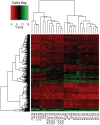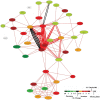Genome wide expression analysis suggests perturbation of vascular homeostasis during high altitude pulmonary edema
- PMID: 24465776
- PMCID: PMC3899118
- DOI: 10.1371/journal.pone.0085902
Genome wide expression analysis suggests perturbation of vascular homeostasis during high altitude pulmonary edema
Abstract
Background: High altitude pulmonary edema (HAPE) is a life-threatening form of non-cardiogenic edema which occurs in unacclimatized but otherwise normal individuals within two to four days after rapid ascent to altitude beyond 3000 m. The precise pathoetiology and inciting mechanisms regulating HAPE remain unclear.
Methodology/principle findings: We performed global gene expression profiling in individuals with established HAPE compared to acclimatized individuals. Our data suggests concurrent modulation of multiple pathways which regulate vascular homeostasis and consequently lung fluid dynamics. These pathways included those which regulate vasoconstriction through smooth muscle contraction, cellular actin cytoskeleton rearrangements and endothelial permeability/dysfunction. Some notable genes within these pathways included MYLK; rho family members ARGEF11, ARHGAP24; cell adhesion molecules such as CLDN6, CLDN23, PXN and VCAM1 besides other signaling intermediates. Further, several important regulators of systemic/pulmonary hypertension including ADRA1D, ECE1, and EDNRA were upregulated in HAPE. We also observed significant upregulation of genes involved in paracrine signaling through chemokines and lymphocyte activation pathways during HAPE represented by transcripts of TNF, JAK2, MAP2K2, MAP2K7, MAPK10, PLCB1, ARAF, SOS1, PAK3 and RELA amongst others. Perturbation of such pathways can potentially skew vascular homeostatic equilibrium towards altered vascular permeability. Additionally, differential regulation of hypoxia-sensing, hypoxia-response and OXPHOS pathway genes in individuals with HAPE were also observed.
Conclusions/significance: Our data reveals specific components of the complex molecular circuitry underlying HAPE. We show concurrent perturbation of multiple pathways regulating vascular homeostasis and suggest multi-genic nature of regulation of HAPE.
Conflict of interest statement
Figures






Similar articles
-
Transcriptomic profiling reveals gene expression kinetics in patients with hypoxia and high altitude pulmonary edema.Gene. 2018 Apr 20;651:200-205. doi: 10.1016/j.gene.2018.01.052. Epub 2018 Jan 31. Gene. 2018. PMID: 29366758
-
[Pathophysiology, prevention and therapy of altitude pulmonary edema].Schweiz Med Wochenschr. 1992 Aug 4;122(31-32):1151-8. Schweiz Med Wochenschr. 1992. PMID: 1496342 Review. German.
-
Shorter telomere length, higher telomerase activity in association with tankyrase gene polymorphism contribute to high-altitude pulmonary edema.Hum Mol Genet. 2020 Nov 4;29(18):3094-3106. doi: 10.1093/hmg/ddaa205. Hum Mol Genet. 2020. PMID: 32916703
-
High-altitude pulmonary edema: from exaggerated pulmonary hypertension to a defect in transepithelial sodium transport.Adv Exp Med Biol. 1999;474:93-107. doi: 10.1007/978-1-4615-4711-2_8. Adv Exp Med Biol. 1999. PMID: 10634996 Review.
-
High altitude pulmonary edema: a pressure-induced leak.Respir Physiol Neurobiol. 2007 Sep 30;158(2-3):266-73. doi: 10.1016/j.resp.2007.05.002. Epub 2007 May 18. Respir Physiol Neurobiol. 2007. PMID: 17602898 Review.
Cited by
-
Patchy Vasoconstriction Versus Inflammation: A Debate in the Pathogenesis of High Altitude Pulmonary Edema.Cureus. 2020 Sep 10;12(9):e10371. doi: 10.7759/cureus.10371. Cureus. 2020. PMID: 33062494 Free PMC article. Review.
-
Acute Changes in Rat Tissue Gene Expression Following Exposure to Flight Relevant Hypobaria.Sci Data. 2025 Jul 24;12(1):1289. doi: 10.1038/s41597-025-05570-z. Sci Data. 2025. PMID: 40707468 Free PMC article.
-
Novel insight into the genetic basis of high-altitude pulmonary hypertension in Kyrgyz highlanders.Eur J Hum Genet. 2019 Jan;27(1):150-159. doi: 10.1038/s41431-018-0270-8. Epub 2018 Sep 25. Eur J Hum Genet. 2019. PMID: 30254217 Free PMC article.
-
H2S Regulates Hypobaric Hypoxia-Induced Early Glio-Vascular Dysfunction and Neuro-Pathophysiological Effects.EBioMedicine. 2016 Apr;6:171-189. doi: 10.1016/j.ebiom.2016.03.002. Epub 2016 Mar 28. EBioMedicine. 2016. PMID: 27211559 Free PMC article.
-
Comparative Transcriptome Analysis of Gayal (Bos frontalis), Yak (Bos grunniens), and Cattle (Bos taurus) Reveal the High-Altitude Adaptation.Front Genet. 2022 Jan 11;12:778788. doi: 10.3389/fgene.2021.778788. eCollection 2021. Front Genet. 2022. PMID: 35087567 Free PMC article.
References
-
- Bartsch P, Maggiorini M, Ritter M, Noti C, Vock P, et al. (1991) Prevention of high-altitude pulmonary edema by nifedipine. N Engl J Med 325: 1284–1289. - PubMed
-
- Bartsch P (1999) High altitude pulmonary edema. Med Sci Sports Exerc 31: S23–27. - PubMed
-
- Grissom C (2006) altitude diseases (HACE/HAPE). In: Fein A, Kamholz SL, Ost D, editors. Respiratory emergencies. London: Hodder Arnold. pp. 253–267.
-
- Durmowicz AG, Noordeweir E, Nicholas R, Reeves JT (1997) Inflammatory processes may predispose children to high-altitude pulmonary edema. J Pediatr 130: 838–840. - PubMed
-
- Grocott M, Montgomery H (2008) Genetophysiology: using genetic strategies to explore hypoxic adaptation. High Alt Med Biol 9: 123–129. - PubMed
Publication types
MeSH terms
LinkOut - more resources
Full Text Sources
Other Literature Sources
Medical
Miscellaneous

